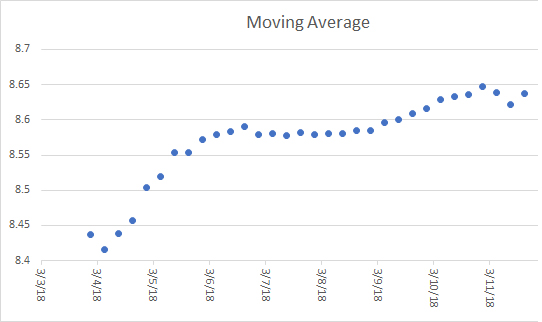-
Posts
2,331 -
Joined
-
Last visited
-
Days Won
119
Content Type
Profiles
Forums
Gallery
Everything posted by SubzeroLT
-
Lovely. Seems to be coloring up nicely.
-
Sea cucumber from reefer Simon. Kenya Tree frag kept detaching from the rock. Using polymorph thermoplastic to loop around the coral to anchor it down. Seems to work. Realized some of the corals have grown quite a bit. Picture from Dec 2016. 15 months later : Bali Slimer. Encrusting on the back wall too. Its a good thing...helping to support & stabilize the rock. 15 months later : Candy Cane SSC from Dec 2016 SSC 15 months later. The center portion seems to have darkened though. Wonder why?
-
Do share more pics (of your tank). Getting the full length gloves?
-
Most folks use booster pumps & do not have this issue. Let's have some discussion here. I hope the container you are using to measure the TDS is 'clean'. Rinse it a couple of times with RODI water then re-measure. I had a friend who used a 'dirty' container to measure output water which triggered a series of unnecessary actions....all because the measurement method was incorrect. The water out from the RO membrane (before DI resin) should be in the 5-10ppm range. Are you getting this? If not, let's debug this.
-
That area runs at about 72W of LED light at the moment. Plants & succulents are doing relatively OK. Its able to hold its coloration & do flower occasionally. Using LEDs (~ 200 PAR for the above lights) are way less lights compared to direct sunlight (~ 1000 PAR)
-
The succulents on the lower shelf is using my old freshwater planted tank lights - Odyssea Evo Green Elements (model 36P 3ft 72W lights).
-
I received some queries about phytoplankton. So here are some comments. The objective of adding phytoplankton is to feed small organisms (zooplankton) which in turn feed larger organisms. Those that benefit most are species that are deemed 'difficult to keep in a reef tank' because they simply starve to death due to missing base of the food chain / zooplankton in the water. (eg. flame scallops or non photosynthetic sea fans). Other corals like SPS generally should benefit as well. Not all phytoplankton are alike (ease vs benefit). Some like Nannochloropsis is generally 'easy' to culture. Hence you see them commonly used for culturing rotifers or used in bottled phyto mixtures. Others like Isochrysis are considered difficult. Difficult means they are sensitive to salinity, temperature & cleanliness & tend to crash easily. Isochrysis is considered the 'gold standard' due to its benefits. Literally, its also 'golden brown' in color. Copy/paste from AlgaeBarn & other websites: Isochrysis is capable of building stores of fats and oils. Isochrysis is high in polyunsaturated fatty acids such as docosahexaenoic acid (DHA), stearidonic acid and alpha-linolenic acid. The Omega 3 composition is often over 22% total fatty acid content. For this reason, it is frequently used to enrich live zooplanktonic feeds (rotifers, copepods, brine shrimp, etc.). It has been used effectively to feed very demanding phytoplanktivorous corals such as Dendronephthya (Carnation Tree Coral). It additionally boasts high concentrations of vitamins (Vitamin A, B1, B2, B6, C, E, folic acid, nicotinic acid, pantotenic acid, etc.). These essential vitamins play a large part in overall health, including factors such as eye health, larval development and growth rates. Isochrysis is also a good source of the amino acids leucine, lysine and alanine. It suppresses growth of dominance of Vibrio spp (a type of bacteria) resulting in improved egg hatching and larval survival Acknowledgement to Chun Wai for the education on phytoplankton. Quite interesting indeed.
-
Verdict on the full length gloves : Its good for keeping your arms dry but not for more 'delicate' work. Not able to pick frag plugs from the sand bed with the gloves on. 3 types of phyto culture going Dripping in about 2 cups of phyto a night. Isochrysis are supposed be beneficial to the juvenile stages of mollusk. i.e. hopefully find developed baby emerald crabs soon
-
Thanks. You can get it from Amazon. Else, Madpetz sells it locally (currently out of stock though)
-
Got a couple of things recently. Full length gloves - up to armpit. Additional Apex PM1 module to enable the 2nd breakout box. Ordered some live phytoplankton that contains accessory pigments for photosynthesis and antioxidents. Not cheap though. That 4 vials came to US$80. FTS : 19th March
-
PMed as well.
-
PMed Sent from my iPhone using Tapatalk
-
Its nice to be able to monitor tank parameters remotely when travelling. 4 measurements/day @ 6hr intervals. Its interesting to see how KH drops during lighting hours & increases again when lights are off at night. This makes me think that its possible to keep KH absolutely constant during the day. Something to think about. Plotting the moving average on excel, it appears to be creeping up marginally. This calls for a 30 minute reduction in CO2 hours for the calcium reactor (that can be done remotely)
-
The negative comments about having a ground probe is mostly about a system that is grounded but not having RCD breaker. This is quite dangerous. All households in SGP have RCD circuit breakers. (in US forums, its is referred to as GFCI breakers). Some kiasu reefers like me have additional RCD circuit breakers installed at the tank cabinet. Having a ground probe is to protect yourself. When there is a surge, the RCD will trip.
-
A similar topic was brought up in this forum about 2 years ago. Assume that there is no single device as the root cause of the leak but when several are turned on together, a voltage is generated via induction of several coils close to each other. Informative page/video on measuring stray voltage instead of using your hand : http://www.reefcentral.com/forums/showthread.php?t=2182599 Its a common issue as many AC pumps are 2 pins & not grounded. Options would be to (1) change the pumps to DC pumps or (2) install a titanium ground probe. My personal preference is (2) - ground probe.
-
Yes, it will work even without the internet or wifi. As long as there is power, its able to test & auto dose KH solution on its own if the auto dose feature is enabled. It triggers the white plug via bluetooth (not wifi) for your 'balance dosing' pump or calcium reactor. The upload to cloud is for data viewing only.
-
Visited 2 reefer's tank over the weekend for PAR measurement service. Very lovely tank & set up indeed. Venturing into softies. Got this Japanese neon Kenya tree from a reefer over the weekend. (polyps not opened yet). Thanks for the nice gesture. Preparing for travel. Set up the large bucket for skim waste & Alkatronic output. Simple DIY to share. Quite a common occurrence that the RODI collection tub or bucket overflows because i forgot about it. Put together a simple water alarm using extra parts lying around. (piezo buzzer, battery holder, float switch)
-
Cerium Oxide. Just search on eBay. It’s not expensive. Personal experience was it’s not worth the effort to polish it off. The glass won’t be flat on the inside anymore since a thin layer of glass is removed. Deep scratches need a lot of effort. Sent from my iPhone using Tapatalk
-
A dreaded task of changing out the calcium reactor pump this weekend. Irritating rattling sound This motor/impeller lasted about 9 months before the rattling sound started to get 'too loud'. Not sure why the impeller does not last very long. Some say its because i run externally & the motor gets warmer. Some say my pH levels are too low (around 6.3pH). New pump. The ceramic shaft from my old pump/impeller. Shaft is still in good condition with slight wear. The design change by Skimz to switch from steel to ceramic shaft was the right one. The noise was caused by the impeller hole getting worn out. Too big a gap now causing it to spin unevenly & rattle. I knew it was likely a worn out impeller but a new motor didn't cost much more. Old pump could still be used as standby. Best practice to change out o-rings when the pump is replaced. Note it does NOT come with the pump. Needs to be purchased separately. Topped up the CR with Rowalith CR media & Grotech Magnesium chips. Mg media goes in first since its smaller & have higher chance of being sucked into the recirculating pump. I don't use the sponge on top anymore. Then purge the CR to get rid of fine particles before letting the effluent flow into the tank. Had a spare heat sink lying around. Attached it to the motor in an attempt for it to run 'cooler'.
-
Thanks Just sharing. I think the product has a lot of potential & benefits with its close loop feedback on KH levels.
-
Lovely!! Thanks for sharing.
-
Very neat set up. Look forward to more updates !
-
Remember to feed your anemones. I didn't feed this max mini carpet anemone for 4 weeks. It took out a perfectly healthy spotted mandarin which must have swam too close. The spotted mandarin was badly stung. Didn't make it. More pics. Midas Blenny found a new fav spot in the rocks. It was opportunistic that the large 6 line wrasse swam into a basket. I took the chance to isolate the 3 year old wrasse & introduce a baby 6 line wrasse. They are both swimming peacefully together for the past week
-
Even though the Alkatronic works just fine as a standalone unit, I hooked it up to my Apex as well (into a pH probe input) KH reading on the Apex classic This is done by syncing the pH calibration between the Apex & Alkatronic. Basically its tricking the Apex to display a PH reading that is actually a KH reading. On the Apex interface : On the Alkatronic app interface :
-
The chart below was based on 12 hour interval readings (9am/9pm) hence more fluctuations are observed. I'm switching to 4 hours now. Regarding accuracy, in my case, there is a small 0.1dKH offset lower compared Salifert manual method. But again, it is known that Salifert optical/color observation method has less accuracy compared to the titration/pH method. I'm not concerned with the offset at all as KH consistency is more important for the hobby. I read that the next software release will allow you to offset the Alkatronic calibration for those who are bothered by the offset & want to match manual methods. Overall happy with the ability to test kH more regularly as its the most important parameter for a stable reef tank. For those using dosing methodology, the Alkatronic unit can accurately dose KH solution & control a power plug to your dosing pump. In my case, the CO2 regulator is hooked to the controlled power plug. If KH is too high, the unit turns off the CO2. Some folks configure it to cut off the feed pump instead. Both method works.


.thumb.jpg.57c2e34da3fe90fcdb8e11c6a93f46a9.jpg)
.thumb.jpg.25e043e32528bcc1e4c70bb882650e20.jpg)
.thumb.jpg.0b31fa5308af13357d3191a77bae4090.jpg)
.thumb.jpg.16ee193611d0fb01ec9b4b5a39ed372e.jpg)
.thumb.jpg.092881a8cfbd3ffd19b896bc6122d775.jpg)
.thumb.jpg.6de842560be509e75b5e485e7b0b7c75.jpg)
.thumb.jpg.10e46d57850cf7abd432bc2c384cf906.jpg)


.thumb.jpg.690631c4b58d8622f67895cb61f84d94.jpg)
.thumb.jpg.4d1b25f29aaa598b468e2e664c11e112.jpg)
.thumb.jpg.c4c0e84ac501c4c34c2a66ac5b8f865b.jpg)
.thumb.jpg.fed7f83b1533da2f37c38b069882d4cc.jpg)
.thumb.jpg.932672a2fc745d8af15cd2f323d71eb1.jpg)
.thumb.jpg.d92e372cce3ca99798d9c6d7e390b384.jpg)

.thumb.jpg.cdef21841a87952e614400039e080eb7.jpg)
.thumb.jpg.f22f8378bc50f8f85327eabb2b78fc38.jpg)
.thumb.jpg.b38d9adae940161be3f38929969f0810.jpg)
.thumb.jpg.117dc1e3f593fe9d9e2a122240d97f0b.jpg)
.thumb.jpg.b25aaa0f604746f4dc5e4a4b701f6a07.jpg)
.thumb.jpg.b9d255e1bc177a519c914c236cedcac2.jpg)
.thumb.jpg.04d486978e1c4d589b7a40e7cbdd003a.jpg)
.thumb.jpg.804f300f119feae374f7c3ea34c26fff.jpg)
.thumb.jpg.8dbfdc166bcc498796197aca625ed631.jpg)
.thumb.jpg.0701789ac6f9670de1cfa500520d0fda.jpg)
.thumb.jpg.2913a381a94e1b7aa7959277053a1d7a.jpg)
.thumb.jpg.304e845b62095c5ef4e8cb816d9457b3.jpg)
.thumb.jpg.4f63439291a7903d679ce3fbda608e36.jpg)
.thumb.jpg.97a46e0a77b0ce1e23f738964fce82ed.jpg)
.thumb.jpg.249f3fb8f010c51ec56c38c24f0fd4c2.jpg)
.thumb.jpg.5a886b4f92932c7bdc90fdd3d1b75061.jpg)
.thumb.jpg.6ccdb5aa41834f391c84f70bfb302c40.jpg)
.thumb.jpg.b8ce082480d969430d702932b59e8b13.jpg)